"Skiff" - a combat laser station
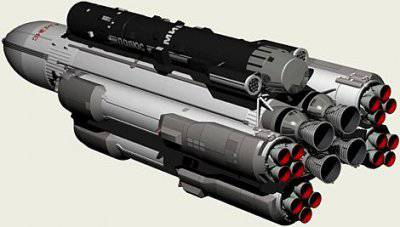 The development of the Skif military laser station, designed to destroy low-orbit space objects with an onboard laser complex, began at Energia, but due to the large load of the Skif organization, from 1981, the topic of creating a laser combat station was transferred to OKB-23 ( Design Bureau "Salyut") (General Director DA Polukhin). This spacecraft with a laser onboard complex, which was created at NPO Astrophysics, had a length of approx. 40 m and 95 T weight
The development of the Skif military laser station, designed to destroy low-orbit space objects with an onboard laser complex, began at Energia, but due to the large load of the Skif organization, from 1981, the topic of creating a laser combat station was transferred to OKB-23 ( Design Bureau "Salyut") (General Director DA Polukhin). This spacecraft with a laser onboard complex, which was created at NPO Astrophysics, had a length of approx. 40 m and 95 T weight18 August 1983 Secretary General of the CPSU Central Committee Yu.V. Andropov made a statement that the USSR unilaterally ceased testing the PKO complex - after which all tests were terminated. However, with the advent of MS. Gorbachev and the announcement in the US of the SDI program work on space defense were continued. To test the laser combat station was designed dynamic analog "Skiff-D", length approx. 25 m and diameter 4 m, in terms of external dimensions, it was analogous to the future combat station. "Skif-D" was made of steel plate, internal bulkheads supplemented and gained weight. Inside the layout is emptiness. Under the flight program, he was supposed to splash down with the second stage of the “Energy” in the Pacific Ocean.
In the future, for a test launch of the Energia launch vehicle, a prototype model of the Skif-DM station (Pole) of length 37 m, diameter 4,1 m and mass 80 t was urgently created.
Spacecraft "Pole" was thought in July 1985g. just like a weight scale layout (GWM), with which the first launch of Energia was to be carried out. This idea arose after it became clear that the main load of the rocket — the Buran orbital ship — would not be ready for this deadline. Initially, the task did not seem particularly difficult - after all, making the 100-ton “blank” is not difficult. But suddenly, Salyut received a wish-order from the minister of general engineering: to turn the blank into a spacecraft for conducting geophysical experiments in near-earth space and thereby combine the tests of Energia and the 100-tonne spacecraft.
According to the practice that has taken shape in our space industry, the new spacecraft has usually been developed, tested and manufactured for at least five years. But now I had to find a completely new approach. We decided to make the most active use of ready-made compartments, devices, equipment, already tested mechanisms and components, drawings from other "products".
Machine-Building Plant them. Khrunichev, who was entrusted with the assembly of the "Pole", immediately began preproduction. But these efforts obviously would not have been enough, if they didn’t support them with energetic actions of the management - every Thursday operational meetings were held at the plant, held by the Minister O.D. Baklanov or his deputy O.S. Shishkin. Sluggish or somewhat disagreeable managers of related companies were “rammed” on these RAMs and the necessary assistance was discussed, if required.
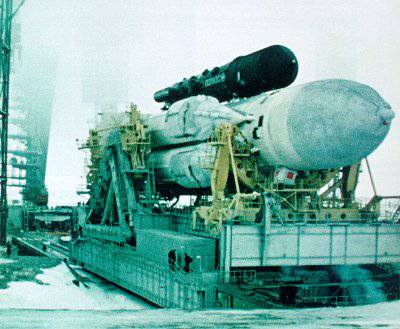 No reasons, and even the fact that almost the same cast of performers at the same time carried out a tremendous work on the creation of "Buran", as a rule, were not taken into account. Everything was subordinated to keeping the deadlines set from above - a vivid example of administrative-command methods of leadership: the "strong-willed" idea, the "strong-willed" execution of this idea, the "strong-willed" terms and - "do not spare money!"
No reasons, and even the fact that almost the same cast of performers at the same time carried out a tremendous work on the creation of "Buran", as a rule, were not taken into account. Everything was subordinated to keeping the deadlines set from above - a vivid example of administrative-command methods of leadership: the "strong-willed" idea, the "strong-willed" execution of this idea, the "strong-willed" terms and - "do not spare money!"In July, 1986, all compartments, including those newly designed and manufactured, were already at Baikonur.
15 May 1987 for the first time from the Baikonur launch site for the first time launched a super-heavy launch vehicle 11K25 Energia С6СЛ (bench-flight). The launch was a sensation for the world of astronautics. The appearance of a carrier of this class opened up exciting prospects for our country. In its first flight, the Energia launch vehicle carried as a payload the experimental Skif-DM apparatus, in open print called the Polyus.
Initially, the start of the system "Energy" - "Skif-DM" was planned for September 1986 of the year. However, due to the delay in the manufacture of the device, the preparation of the launcher and other systems of the cosmodrome, the work was delayed by almost half a year - on 15 May 1987. Only at the end of January 1987, the device was transported from the assembly and test case at the 92-th site of the cosmodrome, where it was trained, to the building of the 11P593 installation and refueling complex at the 112A site. There 3 February 1987 of the year "Skif-DM" was docked with the launch vehicle 11K25 "Energy" 6СЛ. The next day, the complex was taken to the universal complex stand-start (UKSS) 17П31 on the 250 site. There the pre-launch joint tests began. The finishing of the UKSS continued.
In reality, the Energy-Skif-DM complex was ready for launch only at the end of April. All this time, since the beginning of February, the rocket with the apparatus has stood on the launcher. The Skif-DM was fully fueled, inflated with compressed gases and equipped with onboard power supplies. During these three and a half months, he had to endure the most extreme climatic conditions: temperature from -27 to + 30 degrees, blizzard, sleet, rain, fog, and dust storms.
However, the apparatus survived. After extensive preparation, the start was scheduled for May 12. The first launch of a new system with a promising spacecraft seemed so important to the Soviet leadership that it was going to be honored by the presence of General Secretary of the Central Committee of the CPSU Mikhail Sergeyevich Gorbachev by his presence. Moreover, the new leader of the USSR, who took the first post in the state a year ago, had long been intending to visit the main cosmodrome. However, even before Gorbachev’s arrival, the start-up preparation management decided not to tempt fate and to insure itself against the “general effect” (there is such a tendency for any equipment to break down in the presence of “distinguished” guests). Therefore, at 8 May at the meeting of the State Commission, the start of the Energy-Skif-DM complex was postponed to May 15. Gorbachev decided to talk about the technical problems that had arisen. But the General Secretary could not wait three more days at the cosmodrome: on May 15 he had already planned a trip to New York to speak at the UN.
11 May 1987, Gorbachev flew to the Baikonur cosmodrome. 12 May he became acquainted with the samples of space technology. The main point of Gorbachev’s trip to the cosmodrome was an inspection of the “Energy” with the “Scythian-DM”. Then Mikhail Sergeevich spoke to the participants of the upcoming launch.
13 May Gorbachev flew away from Baikonur, and preparations for the launch entered the final stage.
The Skif-DM flight program included 10 experiments: four applied and 6 geophysical experiments. The VP1 experiment was devoted to the development of a large-size spacecraft deactivation scheme using a containerless scheme. In the VX2 experiment, the conditions for the removal of large-sized spacecraft, its design elements and systems were studied. Experimental verification of the principles of constructing large-sized and super-heavy spacecraft (unified module, control systems, thermal control, power supply, electromagnetic compatibility issues) is devoted to the experiment ВХХNUMX. In the experiment ВПХNUMX it was planned to work out the scheme and technology of flight.
The program of geophysical experiments "Mirage" was devoted to the study of the effect of combustion products on the upper atmosphere and ionosphere. The Mirage-1 (А1) experiment was to be carried out to the height of 120 km at the launch stage, the Mirage-2 experiment (А2) - at altitudes from 120 to 280 km at additional development, the Mirage-3 experiment (А3) - at altitudes from 280 to km 0 when braking.
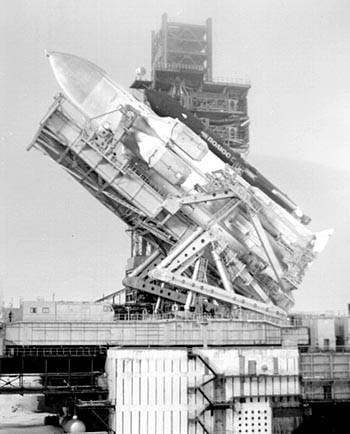 The geophysical experiments of the GF-1 / 1, GF-1 / 2 and GF-1 / 3 were planned to be carried out while operating the Skif-DM propulsion system. The experiment GF-1 / 1 was devoted to the generation of artificial internal gravitational waves of the upper atmosphere. The goal of the GF-1 / 2 experiment was to create an artificial "dynamo effect" in the earth's ionosphere. Finally, the experiment GF-1 / 3 was planned to create large-scale ionization in the ionosphere and plasma spheres (holes and ducts). The Pole was equipped with a large amount (420 kg) of xenon gas mixture with krypton (42 cylinder, each with a capacity of 36 l) and its exhaust system into the ionosphere.
The geophysical experiments of the GF-1 / 1, GF-1 / 2 and GF-1 / 3 were planned to be carried out while operating the Skif-DM propulsion system. The experiment GF-1 / 1 was devoted to the generation of artificial internal gravitational waves of the upper atmosphere. The goal of the GF-1 / 2 experiment was to create an artificial "dynamo effect" in the earth's ionosphere. Finally, the experiment GF-1 / 3 was planned to create large-scale ionization in the ionosphere and plasma spheres (holes and ducts). The Pole was equipped with a large amount (420 kg) of xenon gas mixture with krypton (42 cylinder, each with a capacity of 36 l) and its exhaust system into the ionosphere.In addition, it was planned to carry out 5 military-applied experiments, including shooting targets, on the spacecraft, but before the launch, the Secretary General of the CPSU Central Committee, MS. Gorbachev, where he declared the impossibility of transferring the arms race to space, after which it was decided not to conduct military experiments on the Skif-DM spacecraft.
The launch scheme for the Skif-DM 15 of May 1987 was as follows. After 212 seconds after the lift contact, the head fairing was dropped at 90 km altitude. This happened as follows: in T + 212 s, the longitudinal connector of the fairing was undermined, through 0.3 s, the locks of the first group of the GO cross connector were undermined, and through the 0.3 s the locks of the second group were undermined. Finally, in T + 214.1 s, the mechanical bonds of the head fairing were broken and it was separated.
In T + 460 seconds, at the height of 117 km, the apparatus was separated from the LV Energia. At the same time, the command to transfer the four main propulsion engines to the intermediate thrust level was sent to T + 456.4 seconds. The transition took 0.15 seconds. In T + 459.4, the main command was issued to turn off the main engines. Then through 0.4 seconds this command was duplicated. Finally, in T + 460, a command was issued for the Skif-DM department. After 0.2 seconds after that, the 16 RTDT was turned off. Then, in T + 461.2 s, the first activation of the solid propellant rocket motor for the angular velocity compensation system SKUS was made (via pitch, yaw and roll channels). The second activation of the SSDT SSD, if such was required, was made in T + 463.4 s (roll channel), the third - in T + 464.0 s (via pitch and yaw channels).
After 51 seconds after separation (T + 511 seconds), when Skif-DM and Energy already separated 120 meters, the device began to turn to produce a first pulse. Since Skif-DM started engines forward, it was necessary to turn it 180 degrees around the transverse Z axis in order to fly backwards. By this turn of 180 degrees, due to the peculiarities of the control system of the apparatus, another “turn” was required around the longitudinal axis X by 90 degrees. Only after such a maneuver, called “inverted” by specialists, could the Skif-DM be overclocked to go into orbit.
200 was set aside for "inversion". During this turn, a command was sent to T + 565 seconds to detach the Skif-DM bottom fairing (1.5 separation speed m / s). After 3.0 seconds (T + 568 seconds), commands were issued for the separation of the covers of the side units (speed of separation 2 m / s) and the cover of the zero-emission exhaust system (1.3 m / s). At the end of the reversal maneuver, the antennas of the onboard radar complex were clenched, the covers of the infrared vertical sensors were opened.
In T + 925 seconds, at the height of 155 km, the first activation of four engines for the correction and stabilization of the ACS 417 kg was made. Engine running time was planned 384 seconds, the magnitude of the first impulse 87 m / s. Then, in T + 2220 sec., The opening of solar cells began on the Skif-DM functional service unit. The maximum opening time of the SS was 60 seconds.
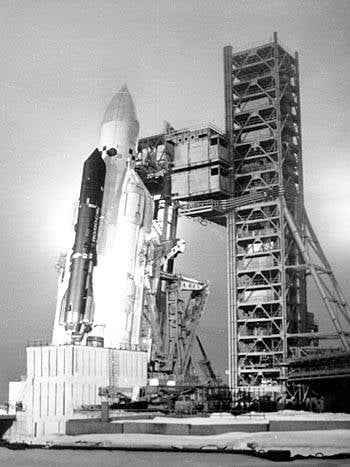 The removal of the Skif-DM was completed at an altitude of 280 km by the second switching on of four DKS. It was produced in T + 3605 seconds (3145 seconds after separation from the PH). The duration of the engine was 172 seconds, the magnitude of the pulse - 40 m / s. The estimated orbit of the apparatus was planned by the circular height of 280 km and the inclination of 64.6 degrees.
The removal of the Skif-DM was completed at an altitude of 280 km by the second switching on of four DKS. It was produced in T + 3605 seconds (3145 seconds after separation from the PH). The duration of the engine was 172 seconds, the magnitude of the pulse - 40 m / s. The estimated orbit of the apparatus was planned by the circular height of 280 km and the inclination of 64.6 degrees.15 May launch was scheduled for 15 hours 00 minutes UHF (16: 00 Moscow time). On this day, already in 00: 10 (hereinafter UHF) began and in 01: 40 the monitoring of the initial state of "Skif-DM" was completed. Previously, the hydrogen tank of the central unit (tank G of unit C) of the carrier was purged with gaseous nitrogen. In 04: 00, the rest of the PH compartments were purged with nitrogen, and after half an hour the initial concentration in the hydrogen tank of the С С 06: 10 to 07: 30 control unit was monitored and the Cube telemetry system was measured and measured. In the 07: 00, the nitrogen preparation of the side fuel tanks was included. Refueling rocket "Energy" began in 08: 30 (at the mark T-06 hours 30 min) with refueling tanks oxidant (liquid oxygen) side and central units. The standard cyclogram provided:
- start at the mark T-5 hours 10 min filling the tank G with hydrogen of the central unit (the duration of filling 2 hours 10 min);
- at the mark T-4 of the hour 40 min, start charging the immersed buffer batteries (BB) in the oxygen tanks of the side units (block A);
- start at the mark T-4 of the hour 2 min charging the immersed BB in the hydrogen tank of the block C;
- at the T-4 mark of an hour, begin refueling the fuel tanks of the side blocks;
- finish in T-3 hours 05 min filling with liquid oxygen of the tanks of unit A and turn them on;
- in T-3 hours 02 min to complete the filling with liquid hydrogen of the central unit;
- in T-3 hours 01 min to complete the refueling of the side blocks and turn on the drain of the filling lines;
- complete in T-2 hours 57 min filling with oxidizer central unit [45,46].
However, during the charging of the carrier, technical problems arose, due to which the preparation for the launch was delayed for a total of five and a half hours. Moreover, the total delay time was about eight hours. However, the schedule of prelaunch operations had built-in delays, due to which they managed to reduce the backlog by two and a half hours.
Delays happened for two reasons. First, there was a leakage of the detachable joint of the pipelines through the control pressure line to disconnect the thermostatically detachable connection and the electrical circuit ejection on the 30A unit due to the abnormal installation of the gasket. Correction of this emergency situation took five hours.
Then it was discovered that one of the two onboard valves in the thermostating line of liquid hydrogen, after issuing an automatic command to close them, did not work. This could be judged by the position of the end contacts of the valve. All attempts to close the valve to no avail. Both of these valves are fixed on the booster on one base. Therefore, it was decided to open the serviceable closed valve "manually" by issuing a command from the control panel, and then issue the "Close" command to two valves at the same time. At the same time a mechanical action from the normally operating valve through the common base to the second valve would be provided. performance of this operation from the "frozen" valve received information about its closure.
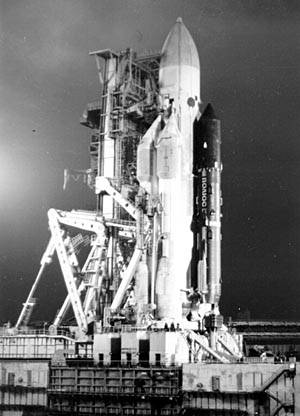 To insure, the commands for opening and closing valves were repeated manually two more times. Each time the valves closed normally. In the course of further preparation for the launch, the "frozen" valve worked normally. However, this emergency situation “snatched” one more hour from the schedule. Another two hours of delays ran up due to malfunctions in some ground equipment systems of the universal integrated stand-start.
To insure, the commands for opening and closing valves were repeated manually two more times. Each time the valves closed normally. In the course of further preparation for the launch, the "frozen" valve worked normally. However, this emergency situation “snatched” one more hour from the schedule. Another two hours of delays ran up due to malfunctions in some ground equipment systems of the universal integrated stand-start.As a result, only in 17: 25 a three-hour readiness for launch was announced, and the entry of operational data on the launch began.
19: 30 has been declared hourly. At the mark of T-47 min, refueling with liquid oxygen of the central unit of the PH began, which was completed in 12 minutes. In 19: 55, the start-up kit for the device has begun. Then in the T-21 min passed the command "Flange 1". After 40 seconds on the "Energy" radio equipment was activated, and in the T-20 mines the pre-launch preparation of the carrier began and the adjustment of the level of kerosene in the fuel tanks of the side blocks and their charging started. For 15 minutes before the start (20: 15), the preparation mode of the Skif-DM control system was activated.
The "Start" command, which initiates the automatic cyclogram of the launch of the carrier rocket, was issued 10 minutes before the start (20: 20). At the same time, the adjustment of the level of liquid hydrogen in the fuel tank of the central unit, which lasted 3 minutes, started. For 8 mines 50 seconds before the start, the boosting began and the refueling of unit A oxidizer tanks with liquid oxygen, which also ended in 3 minutes. In the T-8 mines, the automation of the propulsion system and pyro-means was cocked. In the T-3 min, the command “2 Broach” was executed. For 2 minutes before the launch, the conclusion was received that the machine was ready for launch. In T-1 min 55 seconds, water should have started to be supplied to cool the flue tray. However, problems arose with this, water was not supplied in the required amount. For 1 mines 40 seconds before the lift contact, the engines of the central unit were transferred to the "starting position". Passed the pre-inflation side blocks. In T-50 seconds, the 2 ZDM service platform was withdrawn. For 45 seconds before the start, the afterburning system of the launch complex was activated. In T-14.4 seconds, the engines of the central unit were turned on; in T-3.2 seconds, the engines of the side blocks were started.
In 20 hours 30 minutes (21: 30 UHF, 17: 30 GМТ) the “Lift contact” signal passed, the 3 ЗДМ platform moved away, the transitional docking unit separated from Skif-DM. A huge rocket went into the night velvet-black sky of Baikonur. In the first seconds of the flight, a slight panic arose in the control bunker. After separation from the docking-support platform (block I), the carrier made a strong roll in the pitch plane. In principle, this "nod" was predicted in advance by specialists in the control system. It was obtained due to the algorithm embedded in the Energy management system. After a couple of seconds, the flight stabilized and the rocket went straight up. Later, this algorithm was corrected, and when the “Energy” was launched with “Buran” this “nod” was no longer there.
Two steps "Energy" worked successfully. After 460 seconds after launch, Skif DM separated from the PH at an altitude of 110 km. The orbit, more precisely, the ballistic trajectory had the following parameters: the maximum height of 155 km, the minimum height of minus 15 km (that is, the orbit pericenter was under the Earth's surface), the inclination of the plane of the trajectory to the Earth's equator 64.61 deg.
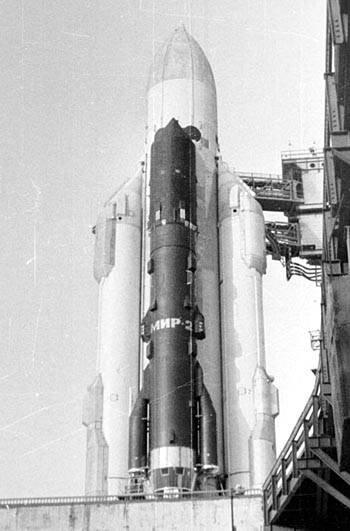 In the process of separation without comment, the system's disposal system using the 16 RTDT worked. At the same time, disturbances were minimal. Therefore, according to the telemetry data, only one of the solid-propellant rocket motors of the angular velocity compensation system along the roll channel worked, which ensured the compensation of the angular velocity 0.1 deg / sec along the roll. After 52 seconds after the separation, the maneuver of the “overturning” apparatus began. Then, in T + 565, a bottom fairing was shot. Through 568, a command was issued to shoot the covers of the side blocks and the protective cover of the SBV. It was then that the irreparable happened: the engines of stabilization and orientation of the SWR did not stop the rotation of the device after its normal rotation by 180 degrees. Despite the fact that the "inversion" continued, according to the logic of the program-temporary device, the covers of the side blocks and the membrane-free exhaust system were separated, the opening of the "Cube" antennas, the shooting of the infrared vertical sensor covers.
In the process of separation without comment, the system's disposal system using the 16 RTDT worked. At the same time, disturbances were minimal. Therefore, according to the telemetry data, only one of the solid-propellant rocket motors of the angular velocity compensation system along the roll channel worked, which ensured the compensation of the angular velocity 0.1 deg / sec along the roll. After 52 seconds after the separation, the maneuver of the “overturning” apparatus began. Then, in T + 565, a bottom fairing was shot. Through 568, a command was issued to shoot the covers of the side blocks and the protective cover of the SBV. It was then that the irreparable happened: the engines of stabilization and orientation of the SWR did not stop the rotation of the device after its normal rotation by 180 degrees. Despite the fact that the "inversion" continued, according to the logic of the program-temporary device, the covers of the side blocks and the membrane-free exhaust system were separated, the opening of the "Cube" antennas, the shooting of the infrared vertical sensor covers. Then, on the rotating Skif-DM, the DKS engines were activated. Not having gained the required orbital speed, the spacecraft went along a ballistic trajectory and fell in the same direction as the central block of the Energia rocket into the waters of the Pacific Ocean.
Whether the solar panels have opened is not known, but this operation should have taken place before the Skif-DM entered the earth’s atmosphere. The software-temporary device of the device worked properly during the withdrawal, and therefore, most likely, the batteries opened up. The reasons for the failure were almost immediately revealed at Baikonur. In conclusion, the results of the launch of the complex "Energy Skif-DM" said:
"... The functioning of all the units and systems of spacecraft ... in areas of preparation for launch, joint flight with the launch vehicle 11K25 6СЛ, separation from the launch vehicle and autonomous flight in the first section before launching into orbit passed without comment. Later on 568 second from the gearing of the gearbox (lift contact) due to the passage of an unforeseen cyclogram command of the control system to turn off the power supply of the power amplifiers of the stabilization and orientation motors (DSL), the product lost orientation.
Thus, the first impulse of the standard 384 duration of a second was issued with an unpaid angular speed (the product made about two full turns in pitch) and after 3127 seconds of flight, due to the non-receipt of the required speed of the overhead, it descended into the Pacific Ocean, in the area of the block dropping " C "launch vehicle. The depths of the ocean at the site of the fall of the product ... are 2.5-6 km.
The power amplifiers were disconnected by a command from the 11М831-22М logic unit upon receipt of a tag from the onboard 2SK Spectrum on-board program-temporary device for resetting the covers of side blocks and protective covers of the system of non-moment exhaust of the product ... Earlier on products 11Ф72 this label was used for disclosure of solar panels with simultaneous blocking DSO. When the PVU-2SK tag was redirected to issue commands to reset the BB and SBV product covers ... NPO Elektropribor did not take into account the link on the 11М831-22М device blocking the DSO operation to the whole area of the first corrective impulse. When analyzing the functional circuits of the control system developed by NPO Electropribor, Salyut did not reveal this outlook either.
The reasons for non-withdrawal of the product ... into orbit are:
a) passing an unforeseen cyclogram of the command of the control system to turn off the power supply to the power amplifiers of the stabilization and orientation motors during a programmed reversal before issuing the first predragon pulse. Such an abnormal situation was not identified during ground testing due to the failure of the lead developer of the NPO Elektropribor control system at the complex stand (Kharkov) to check the functioning of the systems and units of the product ... according to the flight cyclogram in real time.
Carrying out similar work on the KIS of the manufacturer, in the Salyut design bureau or on the technical complex was impossible because:
- factory complex tests are combined with the preparation of the product at the technical complex;
- a complex stand and an electric analogue of the product ... in Salyut Design Bureau were dismantled, and the equipment was transferred to staff the standard product and the integrated stand (Kharkov);
- the technical complex was not equipped by the enterprise NPO "Electropribor" software and mathematical software.
b) The absence of telemetry information on the presence or absence of power at the power amplifiers of the stabilization and orientation motors in the equipment of the control system developed by NPO Electropribor. "
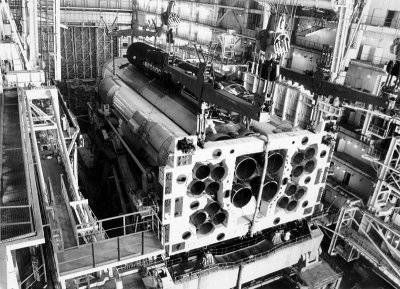 In the control records that the recorders made during the complex tests, the fact of switching off the power amplifiers of the DSO was accurately recorded. But there was no time left to decipher these records - everyone was in a great hurry to launch Energia with Skif-DM.
In the control records that the recorders made during the complex tests, the fact of switching off the power amplifiers of the DSO was accurately recorded. But there was no time left to decipher these records - everyone was in a great hurry to launch Energia with Skif-DM.When starting the complex a curious incident occurred. The Yenisei Separate Command and Measuring Complex 4, as it was planned, began on the second orbit to conduct a radio monitoring of the orbit of the launched Skif-DM. The signal on the Kama system was steady. What was the surprise of experts OKIK-4, when it was announced that Skif-DM, without completing the first orbit in orbit, had sunk into the waters of the Pacific Ocean. It turned out that due to an unforeseen error, OKIK received information from a completely different spacecraft. This happens sometimes with Kama equipment, which has a very wide antenna pattern.
However, the unsuccessful flight of the Skif-DM gave a lot of results. First of all, all the necessary material was obtained for specifying the loads on the orbital ship 11F35OK Buran to support the flight tests of the 11F36 complex (the index of the complex consisting of the launch vehicle 11K25 and the orbital ship 11Ф35OK Buran). All four applied experiments (VP-1, VP-2, VP-3 and VP-11), as well as part of the geophysical experiments ("Mirage-1" and partially GF-1 / 1 and GF -1 / 3). The conclusion on the results of the launch said:
"... Thus, the general tasks of launching the product ..., defined by the launch tasks approved by IOM and UNKS, taking into account the" Decision "from 13 of May 1987 on limiting the scope of target experiments, were completed in more than 80%.
The solved tasks cover practically the entire volume of new and problematic solutions, the verification of which was planned during the first launch of the complex ...
The flight tests of the complex consisting of the PH 11K25 6CL and the Skif-DM satellite were for the first time:
- the working capacity of the super-heavy class PH with asymmetrical lateral arrangement of the output object was confirmed;
- a wide experience of ground operation was obtained at all stages of preparation for the launch of the super-heavy rocket-space complex;
- obtained on the basis of telemetry information of the spacecraft ... extensive and reliable experimental material on the conditions of launch, which will be used when creating spacecraft of various purposes and the ISS "Buran";
- testing of the 100-tonne class space platform for solving a wide range of tasks was started, during the creation of which a number of new progressive layout, design and technological solutions were used. "
Passed during the launch of the complex tests and many elements of the structure, which were later used for other spacecraft and launch vehicles. So, carbon fiber head fairing, first tested in full-scale 15 in May 1987, was later used when launching the modules Kvant-2, Kristall, Spectrum and Nature, and also already made to launch the first element of the International Space Station - Energy block FGB.
The TASS report from 15 of May, dedicated to this launch, said: “In the Soviet Union, flight design tests of a new powerful universal rocket“ Energy ”, designed for launching both reusable orbital spacecraft and large-scale space vehicles for scientific and national economy purposes, were launched A two-stage universal launch vehicle ... capable of putting into orbit more than 100 tons of payload ... 15 May 1987 of the year in 21 hour 30 minutes of Moscow time from the Baikonur cosmodrome the first launch of this rocket ... The second stage of the launch vehicle ... brought the dimensional weight model of the satellite to the calculated point. The size weight model after separation from the second stage had to be put into circular near-earth orbit using its own engine. - due to the non-standard work of its on-board systems, the model did not come out on a given orbit and splashed down in the Pacific Ocean ... ".
The station "Skif-DM", intended for testing the design and on-board systems of a combat space complex with a laser weaponswhich received the index 17F19DM, had a total length of almost 37 m and a diameter of up to 4,1 m, a mass of about 80 t, the internal volume of approx. 80 cubic meters, and consisted of two main compartments: the smaller - functional-service unit (FSB) and the larger - the target module (CM). The FSB was the long-used Salyut design bureau and the 20-ton ship, which was only slightly modified for this new task, is almost the same as the Kosmos-929, -1267, -1443, -1668 transport ships and the Mir ".
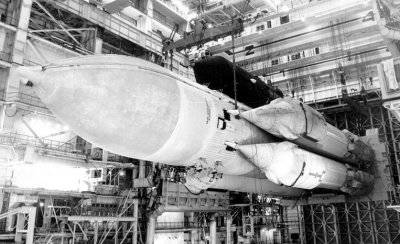 It housed the systems of motion control and on-board complex, telemetry control, command radio communication, provision of thermal conditions, power supply, separation and discharge of fairings, antenna devices, control system of scientific experiments. All devices and systems that do not withstand the vacuum were located in an airtight instrument-cargo compartment (PGO). The propulsion system compartment (ODU) housed four cruise engines, 20 orientation and stabilization engines, and 16 precision stabilization engines, as well as tanks, pipelines and valves in the pneumatic hydraulic system serving the engines. Solar panels housed on the lateral surfaces of the ODE were opened after going into orbit.
It housed the systems of motion control and on-board complex, telemetry control, command radio communication, provision of thermal conditions, power supply, separation and discharge of fairings, antenna devices, control system of scientific experiments. All devices and systems that do not withstand the vacuum were located in an airtight instrument-cargo compartment (PGO). The propulsion system compartment (ODU) housed four cruise engines, 20 orientation and stabilization engines, and 16 precision stabilization engines, as well as tanks, pipelines and valves in the pneumatic hydraulic system serving the engines. Solar panels housed on the lateral surfaces of the ODE were opened after going into orbit.The central unit of the Skif-DM spacecraft was adapted with the Mir-2 ACS module.
The control unit of the Skif-DMN module included the 11D458 and 17D58E engines.
The main characteristics of the Energia launch vehicle with the Skif-DM test module:
Starting weight: 2320-2365 t;
Fuel stock: in the side blocks (blocks A) 1220-1240 t,
in the central unit - 2 level (unit C) 690-710т;
Mass of blocks at separation:
side 218 - 250 t,
central 78 -86 t;
The mass of the test module "Skif-DM" when separated from the central unit, 75-80 t;
Maximum velocity head, kg / sq. 2500.
Source: the site "Troops of the Rocket and Space Defense",
Spacecraft "Buran"
Information